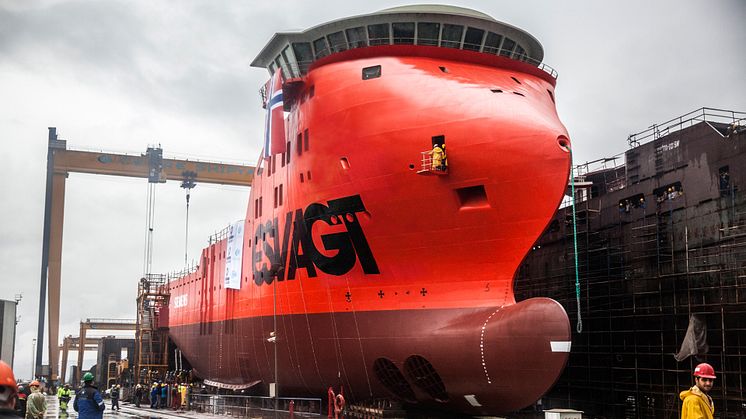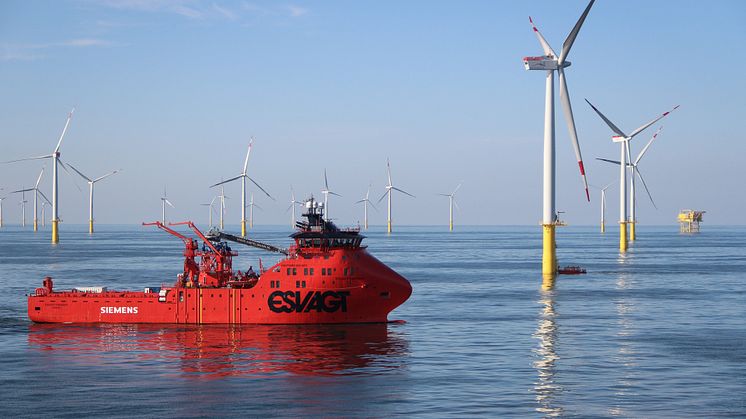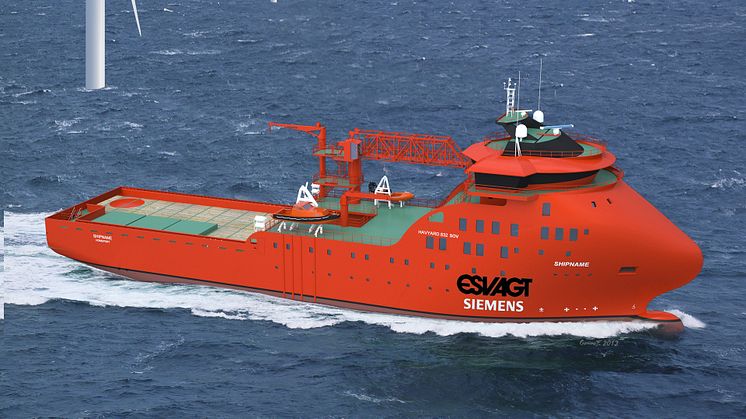
Press release -
HST 118 launched and HST 119 on its way – both with new solutions
ESVAGT’s first service operation vessels for offshore wind farms are well on the way.
The vessels, HST 118 and HST 119, that will function as service vessels for Siemens Windpower are both equipped with a gangway system that – via an advanced gyro compensating system – ensures safe transfer of service technicians between the vessel and wind turbine.
Fast positioning
The Norwegian company, Havyard Ship Technology, designed the HST 118 and HST 119. The hulls are built at the Cemre Shipyard in Turkey, after which the vessels are towed to the Leirvik Shipyard in Norway where they are fitted out, tested and taken into trial.
The HST 118 was launched in Turkey on the 19th of July and is now in Norway. The vessel will now be equipped with the most modern technology to ensure a high level of operating safety, excellent energy efficiency and optimal comfort.
”Our contact with Siemens commits us to ensuring that two technicians can be set down on five wind turbines within a set time frame,” says Kristian Ole Jakobsen.
That demands a great deal of the vessel’s positioning systems:
“Dynamically positioning a vessel typically takes between 20 and 30 minutes depending on the vessel’s propulsion and thruster systems, the accuracy of its DP systems and the local weather and wind conditions. We can position the vessel faster because we have developed a more advanced system with wind farm operations in mind. This system ensures that we can safely position the vessel to transfer service technicians between ship and wind turbine with the gangway system much faster than we can with existing dynamic positioning systems on other vessels in the ESVAGT fleet. Our plan is that the system will allow us to calculate the next positions before we get there, so that we can take wind, weather and current into account before arriving. We will also reuse data from the first positioning manoeuvre to optimise reaction time,” says Kristian Ole Jakobsen.
Direct current for comfort
Another distinctive feature of the HST 118 and HST 119 is that the vessels are equipped with a new and advanced main distribution system based on DC (direct current). Direct current has been used for many years with low current for advanced control and operating systems. Modern developments now mean that direct current can be used for high power distribution systems, making them an alternative to conventional maritime AC systems.
This means that the vessel’s diesel generators supply power at variable and typically lower RPM than before – leading to a reduction in fuel consumption, noise, vibration and wear and tear on rotating machinery.
”The new power distribution system is a big advantage. Partly because it reduces emissions (CO2, NOx, etc.), which is definitely important both for the customer and for us; we are, after all, working in a wind farm that produces green energy, and partly because it means less vibration and noise from the engines and increased comfort for those on board. This will benefit service technicians working or resting on board and the crew, who will have a much more comfortable working environment in the machine rooms. There will be less rumbling and noise on board the vessel. When we go from the typical 1600 to 1800 RPM to around 900 to 1100 RPM depending on the load, we also reduce wear and tear on the motor. This will lead to longer intervals between services,” says Kristian Ole Jakobsen.
Facts
First wind energy contract
The vessels HST 118 and HST 119 will service the turbines in the Baltic 2 wind farm between Møn and Bornholm from January 2015 and for the following five years. From March 2015, they will also service the turbines in the Butendiek wind farm located West of the island of Sylt in the North Sea.
The contract is not only the first wind energy contract; it is also the largest in the history of the shipping company.
Topics
Categories
ESVAGT is a dedicated provider of safety and support at sea, founded on an experienced and well-trained offshore crew and unmatched rescue capabilities.
We support the offshore Oil & Gas industries with a wide range of specialized services: Standby, Emergency Response and Resque Vessels (ERRV), Oil spill response, Firefighting, Tanker assists, Rig moves, Supply services and Interfield transfer of cargo and personnel.
In 2010, ESVAGT brought the dedicated offshore wind Service Operation Vessels (SOV) to the market. The SOVs provide accommodation for up to 40 technicians, storage for small turbine parts and a workshop, plus personnel and equipment transfer capabilities by either Walk-to-Work gangway system or Safe Transfer Boats.
ESVAGT was founded in 1981 and has a fleet of more than 40 vessels and more than 900 employees on- and offshore.




